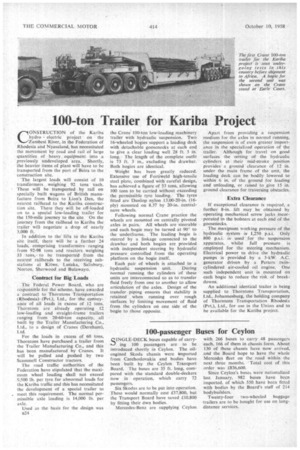100-ton Trailer for Kariba Project
Page 58

If you've noticed an error in this article please click here to report it so we can fix it.
CONSTRUCTION of the Kariba hydro electric project on the Zambesi River, in the Federation of Rhodesia and Nyasaland, has necessitated the movement by road and rail of large quantities of heavy equipment into a previously undeveloped area. Shortly, the heavier items of plant will have to be transported from the port of Beira to the
construction site. .
The largest loads will consist of 10 transfermers weighing 92 tons each. These will be transported by rail on specially built wagons of British manufacture from Beira to Lion's Den, the nearest railhead to the Kariba construction site. There they will be off-loaded on to a special low-loading trailer for the 150-mile journey to the site On the journey from the railhead to Kariba the trailer will negotiate a drop of nearly 3,000 ft.
In addition to the lifts to the Kariba site itself, there will be a further 24 loads, comprising transformers ranging from 92-98 tons and reactors weighing 33 • tons,to be transported from the nearest railheads to the receiving substations at Kitwe, Lusaka, Salisbury, NortOn, Sherwood and Bulawayo.
Contract for Big Loads
The Federal Power Board, who are responsible for the scheme, have awarded a contract to Thorntons Transportation (Rhodesia). (Pvt.), Ltd., for the conveyance of all loads in excess of 12 tons. Thorntons are already operating 12 low-loading and straight-frame trailers ranging from 20-60-ton capacity, all built by the Trailer Manufacturing Co., Ltd., to a design of Cranes (Dereham), Ltd.
For the loads in excess of 60 tons, Thorntons have purchased a trailer from the Trader Manufacturing Co., and this has been manufactured by Cranes. It will be pulled and pushed by two Scannell Constructor tractors.
The road traffic authorities of the Federation have stipulated that the maximum wheel loading shall not exceed 9,500 lb. per tyre for abnormal loads for the Kariba traffic and this has necessitated the development of a special trailer to meet this requirement. The normal permissible axle loading is 14,000 lb. per axle.
Used as the basis for the design was B24
the Crane 100-ton low-loading machinery trailer with hydraulic suspension. Two 16-wheeled bogies support a loading deck with detachable goosenecks at each end to give a clear loading well ,28 ft. 3 in. long., The length of the complete outfit is 73 ft. 3 in., excluding the drawbar. Both bogies are identical.
Weight has been greatly reduced. Extensive use of Fortiweld high-tensile steel plate, combined with careful design, has achieved a figure of 33 tons, allowing 100 tons to be carried without exceeding the permissible tyre loading. The tyres fitted are Dunlop nylon 13,00-20-in. (16ply) mounted on 8.37 by 20-in, centralnave wheels.
Following normal Crane practice the wheels are mounted on centrally pivoted axles in pairs. All wheels are steerable and each bogie may be turned at 90° to the underframe. The leading bogie is steered by a linkage connected to the drawbar and both bogies are provided with independent steering by hydraulic pressure controlled from the operating platform on the bogie itself.
Each pair of wheels is attached to a hydraulic suspension unit. During normal running the cylinders of these units are interconnected so as to transfer fluid freely from one to another to allow articulation of the axles. Design of the transfer piping ensures that stability is retained when running over rough surfaces by limiting movement of fluid from the cylinders on one side of the bogie to those opposite.
Apart from providing' a suspension medium for the axles in normal running, the suspension is of even greater importance in the specialized operation of the trailer. Although for travel on good surfaces the setting of the hydraulic cylinders at their mid-stroke position provides' a ground clearance: of 12 in. under the main frame of the unit, the loading deck can be bodily lOwered to within 6 in. of the ground for loading and unloading, or raised to ,give 15 in. ground clearance for traversing obstacles.
Extra Clearance
If exceptional clearance is required, a further 8-in, lift may be obtained by operating mechanical screw jacks incorporated in the bolsters at each end of the goosenecks.
. The rnaxigium working pressure of the hydraulic systemis 1,250 psi. Only 800 p.s.i.• isused" for the suspension apparatus, whilst full pressure 'is employed for the Steering mechanism, Electrical power to drive the hydraulic pumps is provided by a 5-kW. A.C. generator driven by a Petters twincylindered air-cooled oil engine. One such independent unit is mounted on each bogie to reduce the risk of break
downs. . .
An additional identical trailer is being supplied to Thorntons Transportation, Ltd., Johannesburg, the holding company of Thorntons Transportation Rhodesia (Pvt.), Ltd., for use in the Union and to be available for the Kariba project.




































































































